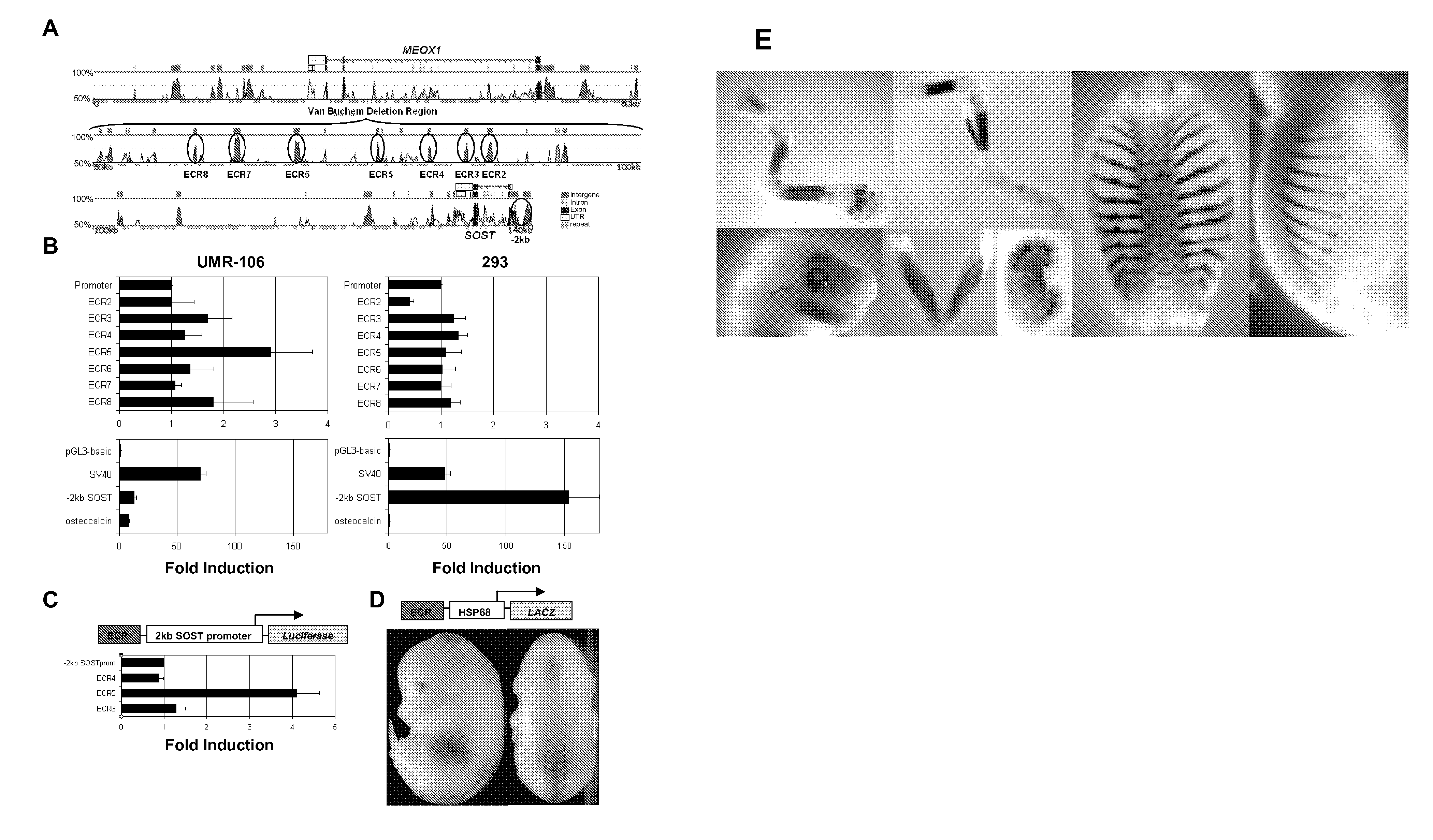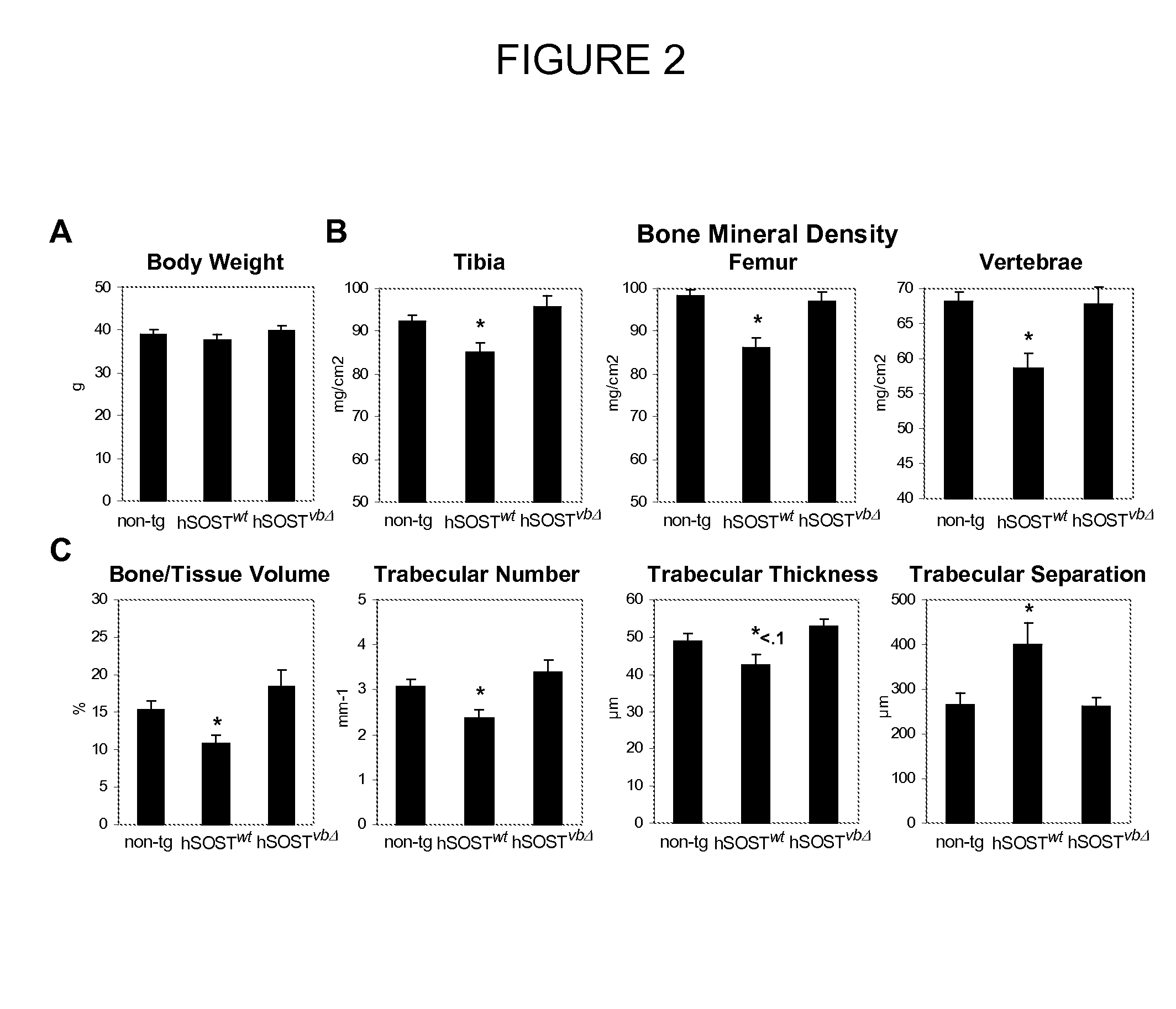Compositions and methods for altering bone density and bone patterning
a technology of bone density and composition, applied in the field of compositions and methods for modulating bone density, can solve problems such as negative modulation of adult bone mass
- Summary
- Abstract
- Description
- Claims
- Application Information
AI Technical Summary
Benefits of technology
Problems solved by technology
Method used
Image
Examples
example 1
Molecular Characterization of Van Buchem
Transgenic Mouse Models
[0194]A ˜158 kb human BAC (RP11-209M4) (SOSTwt) encompassing the 3′ end of the DUSP3 gene, SOST, MEOX1, and 90 kb noncoding intergenic interval separating SOST from the MEOX1 neighboring gene was engineered using homologous recombination in bacteria (Lee, E. C., D. Yu, J. Martinez de Velasco, L. Tessarollo, D. A. Swing, D. L. Court, N. A. Jenkins, and N. G. Copeland. 2001. A highly efficient Escherichia coli-based chromosome engineering system adapted for recombinogenic targeting and subcloning of BAC DNA. Genomics 73: 56-65) to delete the 52 kb region missing in VB patients and to create the VB (SOSTwbΔ) allele (FIG. 1A). These constructs were used to generate several lines of transgenic mice. Similar to the endogenous mouse SOST expression, and reported human expression SOSTwt transgenic animals predominantly expressed the human SOST transcript in the mineralized bone of neonatal and adult mice. In adult tissues, we de...
example 2
Modulation of SOST Expression Impacts Bone Formation
[0198]Since lack of SOST causes increased bone density, it was investigated whether elevated levels of human SOST have opposite effects on bone mass. SOSTwt transgenics grew to skeletal maturity with normal body size and weight (FIG. 2A) however, the animals displayed decreased bone mineral density in the appendicular and axial skeleton, as evaluated by dual energy X-ray absorptiometry (DEXA) analysis (FIG. 2B). Micro-Computed-Tomography (microCT) analysis of three-dimensional cancellous bone structures revealed that the mice have decreased bone volume, trabecular number, thickness and increased trabecular separation (FIG. 2C). In contrast, the bone parameters of SOSTwbΔ transgenics were indistinguishable from non-transgenic littermate controls. The observed osteopenia was gene dose dependent. SOS t transgenic mice bred to homozygosity revealed a further dramatic decrease in tibial cancellous bone volume (FIG. 3A). Histomorphometri...
example 3
Comparative Sequence Analysis and In Vitro Enhancer Assays
[0205]Given the striking bone phenotypes observed in both VB and sclerosteosis patients, we next focused on the identification of noncoding sequences required for SOST bone-specific expression through a combination of comparative sequence analysis and transient transfections assays. We aligned a ˜140 kb human SOST region (URL:) (Ovcharenko, I., G. G. Loots, R. C. Hardison, W. Miller, and L. Stubbs. 2004. zPicture: dynamic alignment and visualization tool for analyzing conservation profiles. Genome Res 14: 472-477) (RP11-209M4; AQ420215, AQ420216) to the corresponding mouse sequences from chromosome 11 (Mouse chr11:101,489,231-101,688,385; Oct. 3 Freeze). (FIG. 5A). A stringent requirement of at least 80% identity over a 200 base pair (bp) window (≧80% ID; ≧200 bp) identified seven evolutionarily conserved regions (ECR2-8) within the vbΔ genomic interval, which were prioritized for in vitro enhancer analysis. ECR2-8 were teste...
PUM
| Property | Measurement | Unit |
|---|---|---|
| Fraction | aaaaa | aaaaa |
| Density | aaaaa | aaaaa |
| Fluorescence | aaaaa | aaaaa |
Abstract
Description
Claims
Application Information
 Login to View More
Login to View More - R&D
- Intellectual Property
- Life Sciences
- Materials
- Tech Scout
- Unparalleled Data Quality
- Higher Quality Content
- 60% Fewer Hallucinations
Browse by: Latest US Patents, China's latest patents, Technical Efficacy Thesaurus, Application Domain, Technology Topic, Popular Technical Reports.
© 2025 PatSnap. All rights reserved.Legal|Privacy policy|Modern Slavery Act Transparency Statement|Sitemap|About US| Contact US: help@patsnap.com



